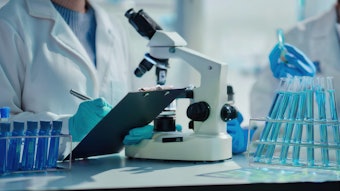At the Personal Care Products Council’s 2008 annual meeting, National Media analysts Alex Castallonos and Bruce Haynes noted that consumers receive disorienting information regarding personal care products from a range of sources, and this information is rarely pro-industry. In this environment, more than 70% of natural product consumers believe that it is important to do business with environmentally responsible companies, according to a recent study conducted by Mambo Sprouts Marketing. This same group also says it will pay up to 20% more for green products. In this context, personal care and beauty products boasting organic compliance have been growing by about 15% annually. Yet confusion with the definition and standards of “organic” abounds, particularly in the personal care and cosmetic category—a dangerous scenario for the industry.
Since 1991, Ecocert (www.ecocert.com) has conducted organic certification in more than 80 countries for a range of fragranced products, including perfumes, detergents and cosmetics. Ecocert demands that a product contain at least 10% organic content to qualify for labeling. In the United States, where no official organic certification exists for the personal care and cosmetic categories, some companies have informally adhered to the U.S. Department of Agriculture’s National Organic Program (USDA-NOP; www.ams.usda.gov/nop/indexIE.htm).
“The USDA’s food standards were never designed for [the personal care and cosmetic] industry, and its strict guidelines limit even certain types of ‘green chemistry’ and pose significant challenges for those seeking to create certified organic products,” says Oasis founding member Tim Kapsner, senior research scientist, Aveda.
Oasis (oasisseal.org), which stands for Organic and Sustainable Industry Standards, is a new industry-led organic labeling effort that addresses the standards gap which exists around the globe while providing wiggle room for formulators as green chemistry evolves. As of press time, Oasis is backed by 30 brand owners, fragrance houses and ingredient suppliers—including Estée Lauder, L’Oréal, Cognis and Oh, Oh Organic. New members will be added on an ongoing basis.
“Since there aren’t any [U.S. organic] regulations in the industry,” Kapsner continues, “producers can say anything they want on an organic label. They can say ‘this is a certified organic product,’ and it doesn’t really have to contain any significant amount of organic content. That confuses customers as to what products are truly organic. There’s no way to judge what a company’s doing, versus what it’s saying right now.”
Founding member Karl Halpert (Private Label Select) adds, “One of our main missions with this is to create some clarity amidst all the chaos.”
Oasis has set its standards as follows:
• A requirement for 85% organic content. This percentage will be continuously evaluated by the Oasis board and eventually raised to 95%. Kapsner notes that no timeline has been set.
• Allowance for up to 15% nonorganic content produced via green chemistry. (See “12 Principles of Green Chemistry.”1)
• No petroleum chemistry is allowed.
Halpert estimates that many allied companies will quickly begin the certification process, which is overseen by the Oasis board and technical review committee, though validation is carried out by an independent third party. “I think you’ll start to see [certified products] within 12 months,” he says, though Kapsner points out that, “some companies can move faster than others, so it’s hard to say how fast it’s going to be.”
Challenges of Raw Material Sourcing
“The biggest [challenge] is supply and demand,” says Kapsner, explaining that certified organic raw material sources for formulators will be the industry’s biggest challenge. “That’s part of the reason why Oasis decided to set the organic content requirement at 85%. It’s high enough to create a demand so that the finished product companies will need to look to their suppliers to supply them with certified organic versions of cosmetic ingredients so that they can meet the standard. That’s the whole objective: get that organic requirement up high enough so that it drives the production of more organic agriculture.”
Halpert adds some personal experience. “I’m a private label manufacturer,” he says, “and I can tell you that one of our challenges as we create a product for a customer [is that as] the orders get large, we start worrying about supply.”
Green Chemistry and Fragrance
The Oasis standards allow for up to 15% of nonorganic content in certified products, which means that the fragrance—often a minor percentage of personal care and beauty formulations—does not necessarily have to be organic. However, fragrances must be produced via green chemistry according to the “12 Principles of Green Chemistry,” authored by Paul Anastas and John Warner. Among the principle’s loosely defined main tenets are calls for less hazardous chemical syntheses, renewable feedstocks, safer solvents and reaction conditions, and degradable chemicals and products.
“That’s what green chemistry really means,” says Kapsner. “Green and environmentally responsible. It doesn’t use a lot of petrochemicals or heavy industrial processes. In the fragrance industry, what it really comes down to is using more whole essential oils and plant extracts as aroma materials. The fragrance industry is unique in that it does allow materials that are whole essential oils and aroma chemicals. Cosmetic product companies that want to use whole essential oils are driving the production of certified organic essential oils and that’s the whole objective of this standard—moving this entire industry to certified organic cosmetic products to drive the production of more organic content.”
Kapsner is quick to add, however, that current technologies don’t always allow for wholly organic fragrances. “Green chemistry is embraced in Oasis. You need to allow some processing to occur to make plant materials into cosmetic ingredients. Some of that processing would be used in the context of this model of green chemistry to create aroma materials.”
Looking Forward
Halpert admits the organization has very high goals for its nascent program. “We really want to become the international standard,” he says. “We want Oasis to be regarded as the symbol that assures consumers that what they see on the label is actually in the product. What really distinguishes Oasis is that it’s a verifiable standard—and it’s not Oasis that’s doing the verifying. Once a product has the Oasis seal, we want consumers to feel the same way they feel when they see the [People for the Ethical Treatment for Animals’] bunny seal on cruelty-free products.”
“I think [organic personal care is] only going to increase as consumers actually reach out to a standard that they know they can trust and know is based on high standards,” Kapsner concludes. “They’re going to gravitate more toward these products.”
For comments from the Oasis board made at the standards launch party, click here.
Back to the May issue.










